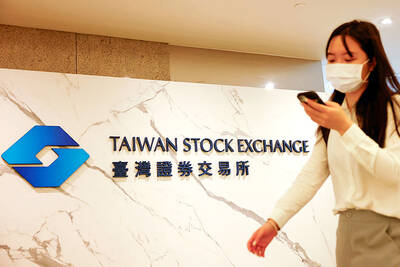A prolonged decline in contract DRAM chip prices is expected to end next quarter, ahead of expectations, as price increases on the spot market have shored up electronic component buyers’ willingness to rebuild inventory following an inventory correction that lasted five quarters, TrendForce Corp (集邦科技) said yesterday.
The market researcher’s latest forecast contrasted with its prediction last month, when it said that overall DRAM chip prices would drop by a single-digit percentage in the first quarter of next year and that prices would likely fall about 50 percent annually this year.
The positive revision came as spot DRAM chip prices rose 0.4 to 2.08 percent yesterday, according to the DRAMexchange Web site.
With a stockpile of downgraded 1x-nanometer DRAM chips being quickly digested, spot prices started to rise, TrendForce said in a report.
The Taipei-based researcher said DRAM used in servers and graphic cards would be the first beneficiaries, as they have seen robust demand lately.
Contract prices for DRAM used in servers are expected to increase 5 percent next quarter from this quarter, it said.
“The trends indicate that original equipment manufacturers for servers are becoming more proactive in building up their DRAM inventories,” TrendForce said.
That has reflected on significant growth in shipments of mainstream DRAM modules used in servers, buoying the prices of memory chips, it said.
TrendForce attributed the price increases to an unstable supply of DRAM chips built using the 1x-nanometer process technology and robust short-term demand.
Contract chip prices for DRAM used in graphic cards are expected to climb slightly next quarter, as microprocessor makers have reduced their inventories to a healthy level and started buying new GDDR6 chips, the researcher said.
Increasing prices of DRAM used in servers and graphic cards would help bring overall DRAM prices to a flat level next quarter, compared with this quarter, it said.
An extensive price rebound is expected to start in the beginning of the second quarter of next year, it added.
DRAM supply still exceeds demand this quarter and the situation would last for two more quarters, the researcher said.

ADVANCED: Previously, Taiwanese chip companies were restricted from building overseas fabs with technology less than two generations behind domestic factories Taiwan Semiconductor Manufacturing Co (TSMC, 台積電), a major chip supplier to Nvidia Corp, would no longer be restricted from investing in next-generation 2-nanometer chip production in the US, the Ministry of Economic Affairs said yesterday. However, the ministry added that the world’s biggest contract chipmaker would not be making any reckless decisions, given the weight of its up to US$30 billion investment. To safeguard Taiwan’s chip technology advantages, the government has barred local chipmakers from making chips using more advanced technologies at their overseas factories, in China particularly. Chipmakers were previously only allowed to produce chips using less advanced technologies, specifically

The New Taiwan dollar is on the verge of overtaking the yuan as Asia’s best carry-trade target given its lower risk of interest-rate and currency volatility. A strategy of borrowing the New Taiwan dollar to invest in higher-yielding alternatives has generated the second-highest return over the past month among Asian currencies behind the yuan, based on the Sharpe ratio that measures risk-adjusted relative returns. The New Taiwan dollar may soon replace its Chinese peer as the region’s favored carry trade tool, analysts say, citing Beijing’s efforts to support the yuan that can create wild swings in borrowing costs. In contrast,

VERTICAL INTEGRATION: The US fabless company’s acquisition of the data center manufacturer would not affect market competition, the Fair Trade Commission said The Fair Trade Commission has approved Advanced Micro Devices Inc’s (AMD) bid to fully acquire ZT International Group Inc for US$4.9 billion, saying it would not hamper market competition. As AMD is a fabless company that designs central processing units (CPUs) used in consumer electronics and servers, while ZT is a data center manufacturer, the vertical integration would not affect market competition, the commission said in a statement yesterday. ZT counts hyperscalers such as Microsoft Corp, Amazon.com Inc and Google among its major clients and plays a minor role in deciding the specifications of data centers, given the strong bargaining power of

TARIFF SURGE: The strong performance could be attributed to the growing artificial intelligence device market and mass orders ahead of potential US tariffs, analysts said The combined revenue of companies listed on the Taiwan Stock Exchange and the Taipei Exchange for the whole of last year totaled NT$44.66 trillion (US$1.35 trillion), up 12.8 percent year-on-year and hit a record high, data compiled by investment consulting firm CMoney showed on Saturday. The result came after listed firms reported a 23.92 percent annual increase in combined revenue for last month at NT$4.1 trillion, the second-highest for the month of December on record, and posted a 15.63 percent rise in combined revenue for the December quarter at NT$12.25 billion, the highest quarterly figure ever, the data showed. Analysts attributed the